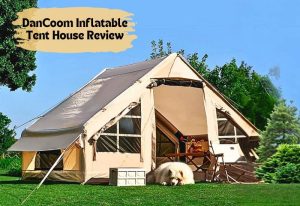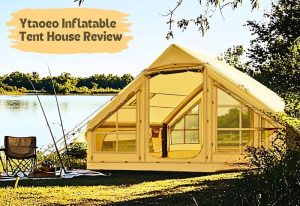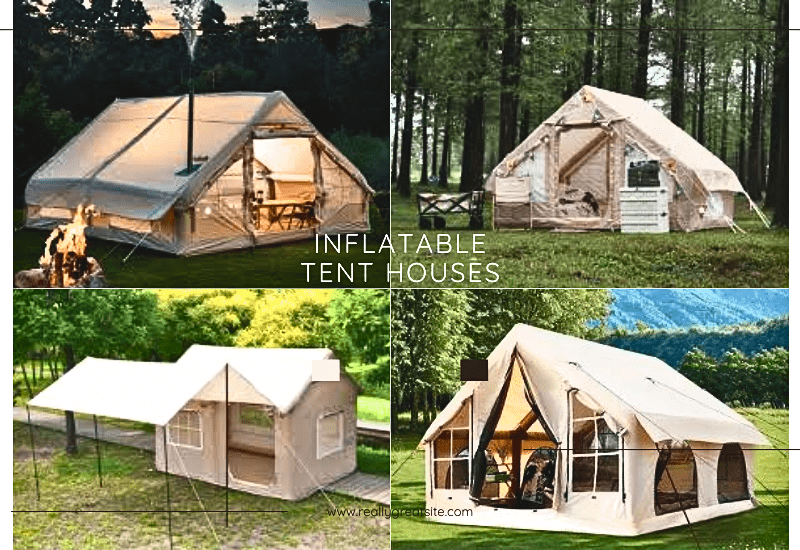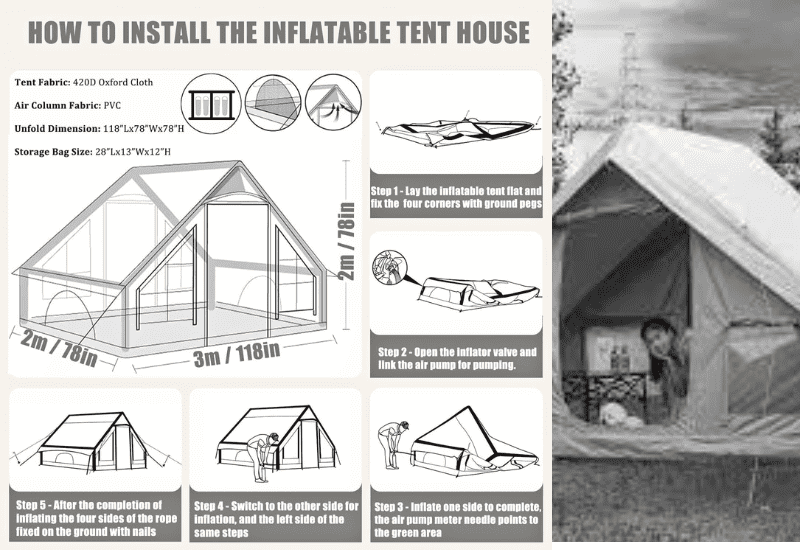Introduction to Inflatable Tent House
Inflatable Tent Houses have revolutionized the world of outdoor shelter. In this comprehensive guide, we will explore the fascinating features, advantages, and practical uses of these innovative Inflatable Tents. Whether you’re an avid camper, outdoor enthusiast, or simply someone intrigued by modern camping gear, this article will provide valuable insights into the realm of inflatable tent houses.
What is an Inflatable Tent House?
Definition and basic concept
The concept of Inflatable Tent House or Inflatable Cabin Tent is rooted in the innovative use of air beams constructed from high-quality TPU (Thermoplastic Polyurethane) and PVC (Polyvinyl Chloride) materials. These air beams, when inflated, provide a sturdy framework for the tent, offering exceptional stability and support. Additionally, the tent’s fabric is crafted from durable, weather-resistant materials, ensuring protection against the elements, making it an ideal choice for outdoor enthusiasts.
Moreover, the portable design of inflatable tent houses makes them convenient for various outdoor activities. The lightweight and compact nature of these tents enables easy storage and hassle-free transportation, addressing the needs of campers who prioritize comfort, convenience, and durability. With their quick setup and user-friendly features, inflatable tent houses and cabin tents are revolutionizing the camping experience.
PRODUCT REVIEWS
When it comes to choosing the perfect inflatable tent house or cabin tent, campers have a wide array of top models to consider. These models are designed to cater to different preferences and camping needs. Let’s take a closer look at some of the top inflatable tent house / inflatable cabin tent models available in the market:
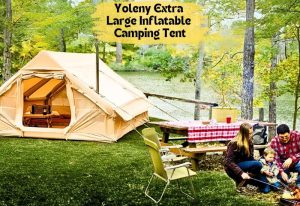
♦ Capacity and size: Fits 6-8 people with extra storage bags, spacious for groups/families. ♦ Setup time: Inflatable setup in 10 minutes using manual pump (no poles). ♦ Fabric Type: Waterproof polyester-cotton blend; breathable, temperature-stable. ♦ What included: Inflatable support post and manual pump for installation. ♦ Additional Features: Winter chimney vent, 8 mesh windows, 2 doors, all-season ventilation. [Read Full Review Here]
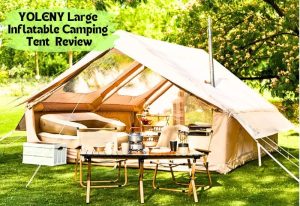
♦ Capacity and size: Spacious design comfortably fits 6-10 people, great for family or a group. ♦ Setup time: Easy one-step setup with an included inflatable pump, save your time and effort. ♦ Fabric Type: Durable 300D Oxford fabric with PU coating provides protection and UV blocking, rainproof. ♦ What’s Included: Includes pump, guylines, and steel stakes, all the tools for installation. manual. ♦ Additional Features: Skylights, mesh windows, stove jack, 3-in-1 windows, and storage pockets, very multi functional. [Read Full Review Here]
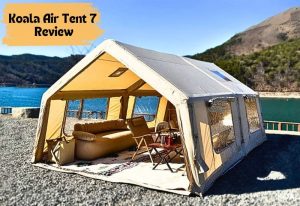
♦ Capacity and size: Accommodates up to 10 people in two rooms. ♦ Setup time: Inflates and sets up in under 10 minutes. ♦ Fabric Type: Made from breathable, durable, eco-friendly Terylene Cotton canvas. ♦ What included: Comes with pump, ropes, rain fly, and repair kit.
♦ Additional Features: Features a stove jack, waterproof design, and excellent ventilation. [Read Full Review Here]
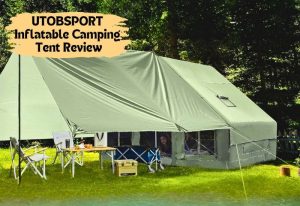
♦ Capacity and size: Sleeps 2-4; 10ft (front) x7ft (depth) x6.6ft (height). ♦ Setup time: Inflates in 10 mins with included pump (electric pump recommended). ♦ Fabric Type: 420D Oxford cloth + PVC base, 5000mm waterproof rating. ♦ What included: Pump, waterproof canopy, mesh/clear curtains, skylight. ♦ Additional Features: 4-season use, airflow mesh, inflatable frame, transparent windows/doors. [Read Full Review Here]
.
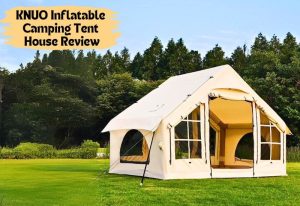
♦ Capacity and size: 7.8 x 7.8 feet, 60 sq ft, fits a double bed. ♦ Setup time: Inflates in 3 minutes with included air pump. ♦ Fabric Type: 1680D Oxford with PVC coating for waterproofing. ♦ What included: Air pump, durable PVC air beams, and other necessary accessories. ♦ Additional Features: Dual-layer windows, bathtub-style bottom, dual zippers, and enhanced UV protection. [Read Full Review Here]
♦ Capacity and size: Accommodates 4-6 people, 9.8 ft × 6.9 ft × 6.4 ft. ♦ Setup time: Ready in 5 minutes with High-Pressure Fast Inflation Air Pump. ♦ Fabric Type: 420D Oxford cloth, waterproof PU3000mm, UPF50+ protection. ♦ What included: Tent, High-Pressure Fast Inflation Air Pump, and other necessary camping gear. ♦ Additional Features: Stove jack, zippered double-layer windows and doors, threshold height and zippers. [Read Full Review Here]
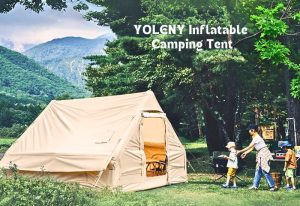
♦ Capacity and size: 4-person, 7’x10′, 68 SqFt interior space ♦ Setup time: Approximately 5 minutes with manual inflatable pump ♦ Fabric Type: 210D Oxford cloth with PU coating, polyester-cotton blend ♦ What’s included: Manual inflatable pump, windproof ropes, durable steel pegs, carrying bag ♦ Additional Features: Flame retardant chimney opening, storage pocket, waterproof, windproof, UV protected [Read Full Review Here]
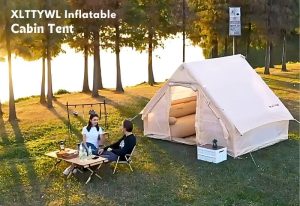
♦ Capacity and size: Accommodates 4 people, 114*80.7*78 inches. ♦ Setup time: 5 minutes, 3-step self-supporting installation. ♦ Fabric Type: Oxford fabric, PU2000 surface, PU1000 bottom. ♦ What included: Inflatable tent, inflator, storage bag, ground pegs. ♦ Additional Features: 2 doors, mesh windows, D-shaped arches, storage pockets, e-port. [Read Full Review Here]
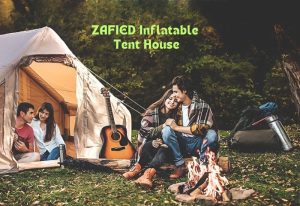
♦ Capacity and size: Fits 4-6 adults, 10 x 6.5 x 6.5 ft, 67.8 sq ft. ♦ Setup time: 5 minutes, no manual support rods needed. ♦ Fabric Type: 420D Oxford cloth, waterproof, windproof, anti-UV. ♦ What included: Tent, pump, guy ropes, stakes, storage bag. ♦ Additional Features: Mesh doors and windows, hang lights, storage bags, reinforced ground nails. [Read Full Review Here]
Difference between Inflatable Tent House and Inflatable Cabin Tent
An “Inflatable Tent House” and an “Inflatable Cabin Tent” both refer to types of inflatable shelters, but they differ in design, purpose, and features. While they may seem similar at first glance, but there are some key differences between the two:
- Design:
– Inflatable tent houses typically have a more traditional tent design, with a single or multiple rooms and a central living area.
– Inflatable cabin tents are designed to resemble a cabin, with vertical walls and a peaked roof, providing more headroom and a spacious interior. - Size:
– Inflatable tent houses are usually larger in size, accommodating more people and gear. They are ideal for family camping trips or group outings.
– Inflatable cabin tents are generally smaller and more compact, making them suitable for couples or small families looking for a cozy camping experience. - Features:
– Inflatable tent houses often come with additional features such as multiple doors, windows, and storage pockets for added convenience.
– Inflatable cabin tents may have fewer features but are designed for a more intimate camping experience, with a focus on comfort and simplicity. - Versatility:
– Inflatable tent houses are versatile and can be used for various outdoor activities such as camping, backyard gatherings, or events.
– Inflatable cabin tents are best suited for camping trips where comfort and a homely feel are desired, making them a popular choice for glamping enthusiasts. - Weather Resistance:
– Inflatable tent houses are designed to withstand various weather conditions, with durable materials and sturdy construction to provide protection from wind, rain, and sun.
– Inflatable cabin tents are also built to be weather-resistant, but their cabin-like design may offer better stability in windy conditions.
In conclusion, while both inflatable tent houses and inflatable cabin tents offer a convenient and hassle-free camping experience, they cater to different preferences and needs. Whether you prefer the spaciousness of a tent house or the cozy feel of a cabin tent, there is an inflatable tent option available to suit your camping style.
Historical background and evolution
The history and evolution of inflatable tent houses is a captivating journey that finds its roots in the mid-20th century. Inflatable tent houses emerged as a revolutionary solution for portable and versatile shelter, catering to the specific needs of campers, outdoor enthusiasts, and adventurers. The early prototypes of inflatable tent houses showcased pioneering design and functionality, laying the foundation for significant advancements in the camping and outdoor shelter industry.
- The Birth of Inflatable Tent Houses: The mid-20th century marked a pivotal moment with the introduction of inflatable tent houses, offering a groundbreaking alternative to traditional camping shelters. This innovation revolutionized the concept of portable and convenient shelter for outdoor activities.
- Early Design Innovations: The early designs of inflatable tent houses exhibited innovative use of materials and air beam technology, setting the stage for the evolution of inflatable shelters. These designs were instrumental in shaping the future of inflatable tents and their applications.
- Remarkable Transformations: Over time, inflatable tent houses have undergone remarkable transformations, incorporating state-of-the-art materials, advanced air beam technology, and cutting-edge structural design. This continuous evolution has contributed to the enhanced durability, stability, and adaptability of inflatable tent houses.
Are these tents suitable for all seasons?
One of the remarkable features of inflatable tent houses is their suitability for various seasons. With built-in ventilation systems, UV protection, and sturdy construction, these tents are designed to withstand different weather conditions, making them ideal for year-round camping adventures.
Let’s delve deeper into the seasonal suitability of these innovative tent houses:
Spring: The ventilation system allows cool air to flow in, creating a comfortable atmosphere for spring camping trips. The UV protection prevents sun exposure and ensures a pleasant experience.
Summer: Inflatable tents excel in the summer, providing ample protection from the sun’s rays and offering a cool and airy interior even in hot weather.
Fall: As the temperatures start to drop, these tents maintain warmth effectively, making them suitable for fall camping adventures.
Winter: With their sturdy construction and insulation, inflatable tent houses are well-suited for winter camping, keeping occupants cozy and secure in cold conditions.
The inflatable design also reduces the chance of moisture getting in, making them suitable for various seasons and weather conditions. Keep in mind that while most models include these features, some may not. Therefore, it’s important to choose carefully when making a purchase.
Key Features of Inflatable Tent Houses
Structure and Materials used (e.g., TPU, PVC)
Inflatable tent houses have become increasingly popular due to their convenience and versatility. One of the key features that make these tents so appealing is their structure and the materials used in their construction. Most inflatable tent houses are made from durable and lightweight materials such as TPU (Thermoplastic Polyurethane) or PVC (Polyvinyl Chloride).
TPU is a popular choice for inflatable tents as it is known for its high strength, abrasion resistance, and flexibility. Tents made from TPU are less prone to punctures and tears, making them ideal for outdoor use in various weather conditions. Additionally, TPU is a more environmentally friendly option compared to PVC, as it is free from harmful chemicals like phthalates.
PVC is another common material used in the construction of inflatable tent houses. It is known for its durability and affordability, making it a popular choice for budget-friendly tent options. PVC tents are also resistant to UV rays and can withstand harsh weather conditions, making them suitable for long-term outdoor use.
In addition to the materials used, the structure of inflatable tent houses is designed for easy and quick setup. Most inflatable tents can be inflated within minutes using an air pump, making them an excellent choice for camping trips, outdoor events, or emergency shelter needs.
Air beam technology and design principles
The key feature of inflatable tent houses lies in their air beam and air frame technology, which consists of inflatable beams or frames that provide structural support to the tent. These beams are typically made from durable materials such as PVC or TPU, which are lightweight yet strong enough to withstand various weather conditions. By using an air pump, these beams can be quickly inflated, allowing the tent to be set up in a matter of minutes.
The design principles behind inflatable tent houses focus on maximizing space and functionality. These tents often feature multiple rooms, windows, and doors, providing ample living space for occupants. Additionally, many inflatable tent houses come with built-in ventilation systems to ensure proper airflow and reduce condensation inside the tent.
In terms of durability, inflatable tent houses are designed to be robust and long-lasting. The materials used are puncture-resistant and waterproof, offering protection against the elements. Some models even come with UV protection to prevent fading and damage from the sun’s rays.
Special features (e.g., air beams, built-in pumps)
Inflatable tent houses or cabin tents offer several distinctive features that make them an attractive choice for outdoor enthusiasts:
– Built-in pumps for easy setup
– Air beam and air frame designs for quick inflation and enhanced stability
– Spacious interiors suitable for family camping
– Customizable options to suit various weather conditions
– Integrated LED lighting for improved ambiance
– Durable materials that are both waterproof and UV-resistant
These features provide convenience, comfort, and versatility, making inflatable tent houses popular for camping adventures. However, keep in mind that not all models come with every feature listed, so be sure to check the specifications before purchasing.
Advantages of Inflatable Tent Houses
Portability and easy setup
Inflatable tent houses or cabin tents are known for their exceptional portability and hassle-free setup, making them the top choice for campers who prioritize convenience and efficiency. The advanced technologies integrated into these tents ensure quick inflation and deflation, allowing campers to set up their temporary home within minutes. Additionally, the compact storage options make transportation a breeze, enabling adventure travelers to carry the tent with ease.
Benefits of Portability and Easy Setup:
- Convenience for on-the-go campers
- Easy and quick to set up, saving time and effort
- Lightweight and portable, making them ideal for camping trips or outdoor events
- Durable and weather-resistant, providing protection from the elements
- Space-saving storage options for easy transport
- Often can be easily customized with different designs, and sizes
- Can accommodate larger groups of people comfortably
- Provides a unique and fun camping experience for both kids and adults
Durability and weather resistance
Inflatable tent houses are built to offer exceptional durability and weather resistance, making them reliable in various environmental conditions. The materials and construction are engineered to withstand the elements, ensuring campers are protected from rain, wind, and UV exposure.
- Durable Materials: The tents are made from high-quality, puncture-resistant materials that are designed to endure rugged outdoor use.
- Weatherproof Design: Seam-sealed construction, reinforced seams, and weatherproof coatings provide additional protection against rain and moisture.
- UV Resistance: Special UV-resistant fabrics shield campers from the harmful effects of prolonged sun exposure.
- Wind Resistance: Aerodynamic designs and sturdy anchor points ensure stability, even in windy conditions.
With these features, inflatable tent houses offer a durable, long-lasting shelter solution that can withstand the challenges of outdoor environments.
Comfort and spaciousness
Inflatable tent houses are designed to prioritize both comfort and spaciousness, making them an excellent choice for campers seeking a hassle-free and enjoyable outdoor experience. These tents provide a generous interior space, allowing campers to move around comfortably and relax without feeling cramped or confined.
Let’s get deeper into the comfort and spaciousness features of inflatable tent houses:
- Roomy Interiors: The interior of inflatable tent houses is thoughtfully designed to offer ample room for relaxation and accommodation. This spaciousness enhances the comfort level of campers, especially during more extended camping trips.
- Multiple Rooms: Many inflatable tent models feature multiple rooms, providing campers with privacy and separation. This is especially beneficial for family camping, as it allows different family members to have their own space while still enjoying the benefits of a shared camping experience.
- Comfortable Seating Areas: Some inflatable tent houses are equipped with designated seating areas, creating a cozy and inviting space for socializing, reading, or simply enjoying the natural surroundings.
- Customization Options: Campers can often customize the interior layout of inflatable tent houses to suit their specific needs, such as creating separate sleeping and living areas, or configuring the space to accommodate camping furniture and equipment.
Overall, the comfort and spaciousness provided by inflatable tent houses contribute to a memorable and enjoyable camping experience for individuals and families alike.
Why they’re becoming popular among campers
The increasing popularity of inflatable tent houses among campers can be attributed to their innovative design, convenience, and versatility. As modern camping essentials, these tents offer a seamless camping experience, prompting more outdoor enthusiasts to embrace the benefits of inflatable shelter solutions.
Disadvantages and Considerations
Initial cost
One of the primary considerations when investing in an inflatable tent house or inflatable cabin tent is the initial cost. The initial cost may seem higher compared to traditional tent options. However, the long-term durability and convenience offered by inflatable tent houses justify the initial investment for campers seeking a reliable shelter solution.
- Factors to consider when evaluating the initial cost:
- Quality of materials used in the construction of the inflatable tent.
- Included accessories and features such as built-in flooring, multiple entrances, and ventilation systems.
- Comparative cost analysis between inflatable tent houses and traditional tents over an extended period.
Potential for punctures and repairs
- While inflatable tent houses or inflatable cabin tents are designed for durability, there is a potential risk of punctures or damage in certain camping environments.
- Campers should be prepared for puncture repair kits and basic maintenance to address any unexpected issues that may arise during outdoor use.
- It is important to understand the common causes of punctures, such as sharp objects on the ground, extreme weather conditions, and improper setup of the tent.
- Below are some tips for preventing punctures and efficiently dealing with repairs:
- When choosing a campsite, clear the area of any sharp objects, rocks, or debris that could potentially puncture the tent material.
- Use a footprint or ground cloth to provide an extra layer of protection between the tent floor and the ground surface.
- Regularly inspect the tent for signs of wear and tear, and promptly address any small damages with a patch kit.
- Consider carrying a lightweight and compact patch kit specifically designed for inflatable tents. These kits typically include adhesive patches, repair tape, and instructions for quick and effective repairs.
- Additionally, it’s a good practice to carry 1 or 2 spare air beams as a safety precaution in case one gets punctured or damaged.
Size and weight limitations
When considering inflatable tent houses, it’s essential for campers to carefully evaluate the size and weight limitations of the tents in relation to their specific camping needs, travel requirements, and accommodation preferences.
- Portability: Inflatable tent houses are designed to offer compact storage and easy portability, making them ideal for campers who prioritize mobility during their trips.
- Accommodation requirements: Campers should assess the size of the inflatable tent houses to ensure that they comfortably accommodate the desired number of occupants and their gear.
- Weather conditions: Consideration should be given to the weight limitations of the tents in connection with the expected weather conditions at the camping site, as heavier tents may provide greater stability in windy or rainy climates.
Further, the size and weight limitations of inflatable tent houses may impact the transport method, storage space in vehicles, and ease of setup and takedown. It’s recommended that campers carefully evaluate these aspects to ensure that the chosen inflatable tent house aligns with their camping requirements, offering both convenience and suitability for the intended adventure.
Practical Uses Beyond Camping
Emergency and disaster relief
Inflatable tent houses or cabin tents are not just for camping trips – they also serve as crucial tools in emergency and disaster relief efforts. These versatile structures are easy to set up and provide temporary shelter for those affected by natural disasters such as hurricanes, floods, or earthquakes. Here are some practical uses of inflatable tent houses beyond camping:
- Emergency shelter for displaced individuals and families
- Medical triage centers in disaster-stricken areas
- Temporary housing for first responders and relief workers
- Distribution centers for food, water, and supplies
- Mobile command centers for coordinating rescue and recovery efforts
Inflatable tent houses offer quick and efficient solutions in times of crisis, providing much-needed support and comfort to those in need.
Festivals and events
When it comes to festivals and events, inflatable tent houses play a vital role in providing convenient and comfortable accommodations for attendees. These innovative structures are designed to elevate the overall experience, ensuring that participants can immerse themselves in the festivities without compromising on comfort or safety.
- Portability: Inflatable tent houses are incredibly portable, allowing for easy setup and relocation as needed. This makes them an ideal choice for events held in various locations, providing organizers with flexibility in creating designated shelter areas.
- Versatility: Their versatile design enables inflatable tent houses to cater to diverse event requirements. They can serve as pop-up changing rooms, information booths, or relaxation areas, enhancing the overall functionality of the event space.
- Weather Resilience: Inflatable tent houses are constructed using durable materials that can withstand various weather conditions, ensuring that attendees remain protected and comfortable regardless of external factors.
Backyard and recreational use
Benefits of Inflatable Tent Houses:
For recreational purposes and backyard activities, inflatable cabin tents and inflatable tent houses provide a versatile and fun shelter option for families and individuals. Whether it’s a backyard camping adventure or a leisurely outdoor gathering, these inflatable shelters offer a unique and enjoyable accommodation experience.
- Create a unique and comfortable space in your backyard for reading, napping, or simply enjoying nature. These tents can serve as a peaceful escape without the need to leave home.
- Fun accommodation experience for families and individuals.
- Hosting a gathering? An inflatable tent house can provide additional sheltered space for guests, making your backyard the perfect venue for parties and events.
- Transform your backyard into an exciting play area for children. These tents provide a safe and fun environment for kids to play, imagine, and explore.
- Easy setup and takedown for quick use and storage
How to Choose the Right Inflatable Tent House
Size and Capacity
- Consider the number of people who will be using the inflatable tent house. It’s essential to choose a size that comfortably accommodates everyone. Refer the Table area by the number of person.
- Think about the interior space needed for sleeping, storage, and moving around. A larger tent provides more room for activities and storage.
- Pay attention to the dimensions, both in terms of floor area and peak height. This will help you gauge the overall spaciousness and comfort.
Quality, Durability, Material
When choosing an inflatable tent house, it is essential to consider the quality, durability, and material to ensure a long-lasting and reliable camping experience. Here are some key points to keep in mind:
- Quality: Look for tents made from high-quality materials that are designed to withstand various weather conditions. A high-quality inflatable tent will offer better protection and comfort during your camping adventures.
- Durability: Consider the durability of the tent fabric, seams, and construction. Reinforced stitching, sturdy zippers, and robust poles contribute to the overall durability of the inflatable tent.
- Material: Evaluate the materials used in the tent’s construction. Durable, waterproof, and UV-resistant materials are ideal for inflatable tents, providing enhanced protection and longevity.
Budget considerations
When deciding on the right inflatable tent house or cabin tent, it’s important to consider your budget. Here are some key budget considerations to keep in mind:
- Set a realistic budget: Before starting your search, determine how much you are willing to spend on an inflatable tent house or cabin tent. This will help narrow down your options and prevent overspending.
- Compare prices: Take the time to research and compare prices from different retailers to ensure you are getting the best deal possible.
- Consider the long-term investment: While it may be tempting to opt for the cheapest option available, consider the quality and durability of the tent. Investing in a higher-quality tent may save you money in the long run by lasting longer and requiring fewer replacements.
- Look for sales or discounts: Keep an eye out for sales, promotions, or discounts on inflatable tent houses or cabin tents to get the best value for your money.
- Factor in additional costs: Remember to factor in any additional costs such as shipping fees, accessories, or maintenance when budgeting for your tent purchase.
By carefully considering your budget and following these tips, you can choose the right inflatable tent house or cabin tent that meets your needs without breaking the bank.
Setting Up and Maintaining Your Inflatable Tent House
Step-by-step setup guide
When it comes to setting up your inflatable tent house, following a clear and concise step-by-step guide is crucial for a successful and hassle-free assembly. Here, we provide an in-depth walkthrough of the setup process, including important considerations and tips to ensure a sturdy and secure installation.
Check items in hand: (1) Inflatable tent (2) Air pump (3) Guy lines and stakes (4) Ground tarp; Instruction manual
- Before inflating your tent, carefully select a suitable and level area for setup. Ensure that the ground is free from sharp objects, rocks, and debris to prevent punctures or tears in the tent material.
- Begin by unpacking your inflatable tent and organizing all the components. Lay out the ground tarp and set aside the guy lines and stakes for later use.
- Using the air pump, slowly inflate the tent while ensuring that it expands evenly. Take breaks if necessary to allow the material to stretch and adjust.
- Once the tent is fully inflated, secure the guy lines and stakes to anchor the tent securely to the ground. Ensure that each line is taut and that the stakes are firmly driven into the ground.
- Take a final inspection of the tent, ensuring that all zippers are properly closed and that no part of the tent is under strain. Make any necessary adjustments before fully utilizing your inflatable tent house.
Storage recommendations
Proper storage is essential for prolonging the life of your inflatable tent house. Here are some detailed storage recommendations to keep your tent house in top condition:
- Thoroughly clean and dry the tent before storing it to prevent mold and mildew growth.
- Store the tent in a cool, dry place, away from direct sunlight and extreme temperatures to prevent material degradation.
- Use a storage bag or container that is large enough to hold the tent without excessive folding or compression.
- Consider using desiccants or moisture-absorbing packets to maintain low humidity levels inside the storage container.
- Regularly inspect the stored tent for any signs of damage or pests, and address any issues promptly.
Common issues (e.g., leaks, punctures)
When it comes to inflatable tent houses, there are several common issues that can arise. Being aware of these issues and knowing how to address them can ensure that your inflatable tent house remains in good condition for a long time.
Here are some common issues to watch out for:
- Leakage: One of the most common problems with inflatable tent houses is leaks. These can occur due to wear and tear, punctures, or faulty seams. It’s important to regularly inspect your tent house for any signs of leakage and address them promptly.
- Punctures: Punctures can occur due to various reasons such as sharp objects, excessive pressure, or rough handling. Repairing punctures promptly and using patch kits can help prevent further damage.
- Seam issues: Faulty seams can lead to air leakage and compromise the structural integrity of the tent house. Regularly checking the seams and ensuring they are well-sealed is essential for maintaining the durability of the inflatable tent.
- Mold and mildew: In humid or damp conditions, mold and mildew can develop on the fabric of the tent house. Regular cleaning and proper ventilation can help prevent the growth of mold and mildew.
Tips for Maintenance and Care
When it comes to maintaining and caring for your inflatable tent house or cabin, there are several important considerations to keep in mind. Proper maintenance not only ensures the longevity of your shelter but also enhances your overall camping experience. Here are some valuable tips for maintenance and care:
- Regular Cleaning: Keep your inflatable tent house clean by regularly wiping down the surfaces with a mild soap and water solution. This helps prevent the buildup of dirt, dust, and grime, ensuring that your shelter remains in top condition.
- Inspection and Repairs: Routinely inspect your inflatable tent house for any signs of wear, tear, or damage. Small punctures or leaks can often be repaired using patch kits designed for inflatable products. Addressing issues promptly can prevent larger problems from developing.
- Proper Storage: When not in use, store your inflatable tent house in a cool, dry place away from direct sunlight and extreme temperatures. This helps prevent material degradation and extends the lifespan of your shelter.
- Inflation and Deflation: Always follow the manufacturer’s recommended guidelines for inflating and deflating your tent house. Overinflation or underinflation can affect the structural integrity of the shelter and may lead to premature wear.
- Weather Considerations: Be mindful of weather conditions when using your inflatable tent house. Avoid setting it up in areas prone to strong winds or sharp objects that may cause damage.
- Supportive Surfaces: Place your tent house on a flat, even surface free of debris and sharp objects. This helps prevent punctures and ensures optimal stability.
Future Trends in Inflatable Tent Technology
Innovations and new materials
When it comes to inflatable tent technology, innovations and new materials play a pivotal role in shaping the future landscape. Manufacturers and researchers continue to explore and develop advanced materials and technologies to enhance the performance, durability, and versatility of inflatable tents. Here are some key developments in innovations and new materials:
Advanced Fabric Composites: Innovations in fabric composites have led to the creation of lightweight, yet durable materials that offer superior resistance to wear, tear, and outdoor elements. Examples: High Tenacity polyester, Dyneema Composite Fabric (DCF), Ripstop Nylon, Polyether Ether Ketone (PEEK). These advanced composites enhance the structural integrity of inflatable tents while enabling them to withstand varying environmental conditions.
Smart Textiles: The integration of smart textiles, such as breathable and moisture-wicking fabrics, enhances comfort and functionality within inflatable tent designs. These textiles are designed to adapt to different weather conditions, providing optimal ventilation and moisture management for a more enjoyable camping experience.
Nanotechnology Coatings: Nanotechnology coatings have revolutionized the protective properties of inflatable tent materials. These coatings provide enhanced water repellency, UV resistance, and antimicrobial features, ensuring prolonged tent lifespan and improved performance in outdoor settings.
Innovative Inflation Systems: Advancements in inflation systems, including high-efficiency pumps and valve mechanisms, contribute to rapid and effortless setup of inflatable tents. These systems streamline the deployment process, making inflatable tents more accessible and user-friendly for outdoor enthusiasts.
Environmental impact and sustainability
Inflatable tent technology has the potential to significantly reduce the environmental impact of traditional camping and shelter systems. By utilizing eco-friendly materials and innovative design concepts, inflatable tents contribute to sustainability in several ways:
- Energy-efficient manufacturing processes reduce carbon emissions and waste.
- Use of recyclable and biodegradable materials minimizes environmental impact.
- Compact and lightweight design decreases fuel consumption during transportation.
Market trends and statistics
Market trends in the inflatable tent industry exhibit a fascinating pattern of growth and evolution. Here are some key points to consider:
- Increased Demand: The market for inflatable tents namely Tent Houses and Cabin Tents has witnessed a significant surge in demand, driven by the growing popularity of outdoor activities, camping, and events.
- Emerging Geographical Markets: New geographical regions are emerging as key markets for inflatable tents, presenting opportunities for expansion and strategic partnerships.
- Technological advancements: Inflatable tents with integrated smart features and eco-friendly materials, have contributed to the market expansion.
- The demand for inflatable tents is notably high in regions with a strong camping and outdoor recreation culture, such as Europe, Australia and North America.
- Furthermore, the incorporation of sustainable and recyclable materials in inflatable tent production has led to a positive impact on the market’s environmental footprint.
Let’s delve into some prominent statistics that highlight the current state of the inflatable tent market:
Global Market Size: Market Analysis Estimated Year Value (2022E) US$ 969 Million. Projected Year Value (2028F) US$ 1,496.0 Million. a compound annual growth rate CAGR (2022 to 2028) of 7.5 %
Consumer Preferences: An increasing number of consumers are preferring inflatable tents due to their portability, quick setup, and durability.
Market Segmentation: The market is segmented into camping tents, event tents, and emergency response tents, each witnessing significant growth in demand.
Conclusion
In summary, inflatable tent house and inflatable cabin tent represents a modern, innovative approach to camping shelters, offering a blend of convenience, durability, and portability for outdoor enthusiasts. With their quick inflating technology, durable materials, and spacious interiors, these inflatable shelters have become a staple in the realm of modern camping essentials, catering to a wide range of practical uses beyond traditional camping.



